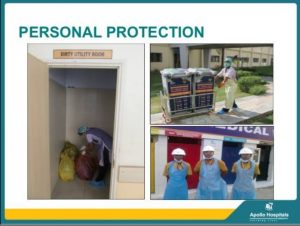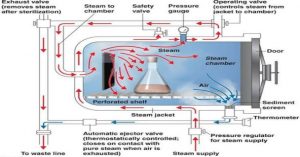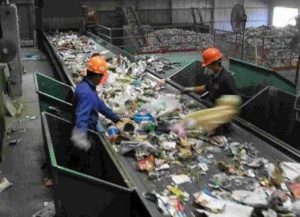In the current scenario when there is a high demand for personal protective equipment (PPE), many manufacturers have come up to fullfill the needs of nation during this pandemic “covid-19”.

The main problem after this pandemic would be the accumulation of huge medical waste which can be hazardous to the environment and Living creatures. Another question will be how would medical centers, hospitals and clinics would deal with this medical wastage which will be in tons and tons. And with such huge and massive amount of hazardous wastes produced by hospitals will need effective and safe ways to dispose.
The world health organisation (WHO) have stated some guidelines for the ways to treat with medical waste which are as follows:
Handling
Hospital staff who handles waste have very high responsibility. Hospital staff who handles waste should always be cautious for their safety because after certain amount of time when develop routine they become less cautious which may affect their safety and may get infection or get contamination injury. Staff members handling medical wastage should be trained time to time which will help as reminder and refresh their minds and also learn handling techniques, amount of risk contained and information about process dealing with accidents, spillage, how to use protective clothing to avoid risk. Correct waste handling. Should be demonstrated to other staff members too .
Storage
For Medical waste hospitals and centers should provide specific place were Medical wastage can be stored temporarily with the hospital premises. It should be taken care during construction of hospital were this place should not be near food preparation area, supply and storage room, or medicine storage room. Waste should be segregated taking proper safety and care measures and divided in disposal waste and hazardous waste. This segregation should be handled by waste management staff. Wastage should be monitored time to time closely and should be removed with specific period of time. And wastage containers should be effectively labelled as hazardous, non hazardous and disposable wastes which can not be mixed.
Treatment
Yes, healthcare activities generate waste, but only about 20% of these hospital wastes are biohazard wastes that could be infectious, toxic, or radioactive.Though 20% doesn’t seem like it’s a whole lot, hospitals produce about 5.9 million tons of waste annually, which means that about 1,070,477,990 kilograms of biohazard waste produced each year. NaturallyNaturally, there’s a huge demand for hospital waste management. Yet few actually know what medical waste disposal methods are actually employed to deal with the heavy amount of biohazard waste. Here are just a few of the most successful medical waste disposal solutions currently used in the industry today.
Autoclaving
Autoclaving it uses a heated container to destroy waste that is one of the most

effective ways to deal with bio hazard wastes. In fact, about 90% of bio hazard waste is autoclaved or incinerated at roughly 2,400 medical waste incinerators (MWI)
Encapsulation
One type of biohazard waste known as sharps requires that special precautions be taken. Sharps are, as the name implies, sharp, and can easily tear or puncture what’s containing them, which can consequentially allow them to easily spread infection. Used syringes, scalpels, and other sharp medical materials need to be encapsulated in a properly labeled, puncture resistant container, and placed in an appropriately designated spot for deposition in a landfill.
Mechanical treatment
treatment to tear waste apart goes by verbs: granulate, pulverizes, shreds, grinds, mixes, agitation, and crushing. This can reduce the bulk volume of the waste by 60 percent or more. Waste can be moved through the processing facility with augers, conveyor belts, and other material handling systems.Mechanical treatment does not kill pathogens or disinfect equipment, but it can reduce waste volume in preparation of further treatment or disposal

Chemical treatment
Chemical disinfection, primarily through the use of chlorine compounds, kills microorganisms in medical waste and can often oxidize hazardous chemical constituents. Chlorine bleach has been used for disinfecting processes for years – you might use it to clean your underwear and kill the e.coli. Chlorine compounds are used in swimming pools to reduce the risk of disease transmission. Ethylene oxide treatment is used to disinfect materials and is sometimes used in treatment of medical waste.
Choices of treatment technologies should be made in line with a clear knowledge of the waste to be managed and the goal to be achieved through treatment. If the technology is to be environmentally sound than a growing concern among health care providers is the wastage should be able to be treated without creating other hazardous by-products.
There are some basic processes for the treatment of hazardous components in health-care waste, specifically, sharps, infectious and pathological wastes: thermal, chemical, irradiation, biological, mechanical, incineration, autoclave, vitrification, Gast sterlization.
Transport
Transporting hazardous medical waste should comply with national regulations, and with international agreements if wastes are shipped across an international frontier for treatment. As with storage, hazardous and non-hazardous waste should always be transported separately. Drivers of vehicles carrying waste should have appropriate training regarding regulations, waste classifications and risks, labeling and documentation, safe handling and emergency procedures. Drivers should also be

declared medically fit to drive vehicles and are recommended to have vaccination against tetanus and hepatitis A and B.
Disposal
Medical waste disposal firms are available to pick up waste that cannot be treated onsite. Waste is then treated and deposited in carefully designed and protected landfills.
Conclusion
As per study these are different ways do deal with medical waste but in case of personal protective equipment (PPE) kits if manufacturers use raw material which is degradable in soil which won’t harm environment and living creatures were in interview with one of manufacturer (anonymous) he said they use raw material which can be degradable in soil in 90 days. Study included all the ways that helps disposal of all type of medical wastage including Meditex waste. I feel there is alot of scope in this field for research and development of not only treatment of wastage but also developing new ways of Meditex articles which are safe, breathable, comfortable and degradable.
Authored by-
Urvi Gosar – Intern ( TVC )

